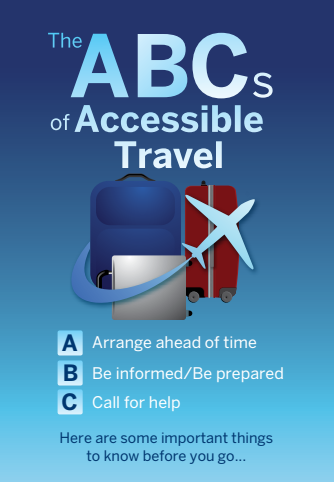Click through each drop-down to view a high-level description of each step of taking a flight for an individual with a physical disabilities. While much of this information is applicable to all types of disabilities and accessbility needs, this content will focus on processes for those those with disabilities who need or travel with mobility aids.
Accessible Travel Guide
You can arrange for:
- Wheelchair or Guided Assistance: Help with boarding, deplaning, or connecting to another flight.
- Seating Accommodations: Seats that meet your disability-related needs.
- Assistive Devices: Loading and stowing of any assistive devices, including hazardous materials packaging for wheelchair batteries.
- Medical Equipment: Hook-up for a respirator to the aircraft's electrical power supply, medical oxygen for use onboard (if offered by the airline), and carriage of an incubator.
- Special Transportation Needs: Transporting a powered wheelchair on an aircraft with fewer than 60 seats, and provision of an onboard wheelchair on an aircraft without an accessible lavatory.
- Group and Special Accommodations: Arrangements for a group of ten or more individuals with disabilities traveling together, and accommodation for a passenger who must travel on a stretcher.
On arrival at the airport, you must go to our Check-in desk of your airline to confirm your accessibility needs. If you need Wheelchair Assistance to the gate, you can confirm this at check-in. Assistance will help you through security, to your gate and on to the aircraft.
You are not required to use Wheelchair Assistance to the gate if you use a wheelchair/bring your own and prefer to get to the gate on your own. Assistance can be requested for boarding only.
Upon arriving to the security checkpoint (with Assistance staff or on your own) there will be a designated line for those with mobility needs.
- Inform the TSA Officer: Let them know if you can walk or stand on your own. If you have trouble standing, ask for a chair or request to be screened while seated in your wheelchair or scooter.
- Mobility Aids: Walkers, crutches, canes, and other aids must go through X-ray screening. If they don't fit, a TSA officer will inspect them. Tell the officer if you need your device back right away after screening.
- Wheelchairs and Scooters: TSA officers will check wheelchairs and scooters, including seat cushions and any attached pouches. They will test for explosives and screen removable items with X-rays. The officer will also inspect the cushions and may use other methods to clear them.
- If you are able to stand and walk, you will be screened by technology. If you are ineligible for screening by technology, a pat-down will be conducted. Pat-downs are conducted by a TSA officer of the same gender and will require the removal of items such as shoes, belts, or light jackets.
Find more details about procedures for medical devices on the TSA Care site.
Visit the gate agent and confirm assistance that is needed to board the aircraft. If you utilized Wheelchair Assistance, they can help with this.
If you are gate checking a mobility device, you will need to receive the proper tags from the gate agent. Your device must be returned to you in a timely manner as close as possible to the door of the aircraft, unless you ask to pick it up in baggage claim. Airlines must check and return your assistive device in the same condition as it was received.
Pre-boarding is allowed for all passengers needing assistance or needing extra time to board. If you are unable to walk to your seat, an aisle chair will be used. This is a small wheelchair that is used to transport passengers from their own wheelchair to a seat on the airplane. They can also be used during the flight to access the lavatory.
Using an Aisle Chair:- Transfer Process: Aisle chairs are placed next to your wheelchair for an easy side-to-side transfer.
- Assistance Available: If you can't transfer yourself, trained staff can lift you into the aisle chair.
- Provide Guidance: Let the staff know the best way to help you. If any part of your body is sensitive or painful, be sure to tell them.
The crew will assist you with boarding and disembarking, accommodation on board and in-cabin information. However, it cannot help you with your personal care, movement or eating.
For layover flights, it is your right to have your mobility device brought to the gate for you to use during the duration of the layover. Upon receiving your wheelchair or assistive device, do a quick inspection before you use it. If there is any damage go immediately to the airline’s customer service and file a claim.



